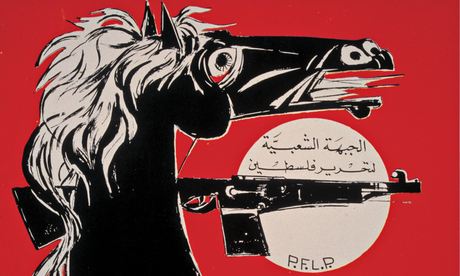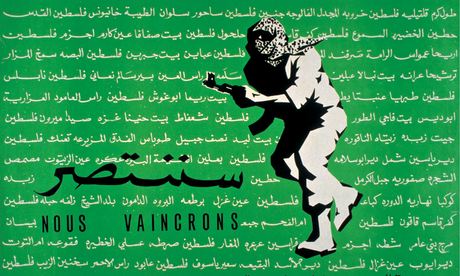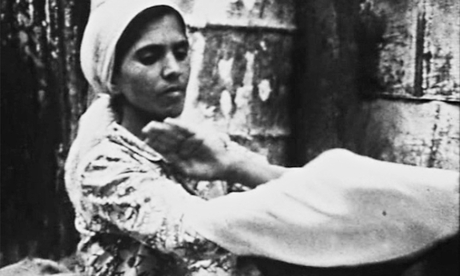
Advancing the Revolution with Weapons and Thought, in Pursuit of Liberation and Socialism, 1974, by Rafeik Sharaf. Courtesy of the Palestine Poster Project Archives (PPPA)
The series of Palestinian revolutionary films and art
now showing at venues in London, under the slogan "The World is
with Us", highlights the important fact that the Palestinian vision of
"us" included Arab and international participants. Iraqi, Jordanian,
German, Syrian, Egyptian, Lebanese, Italian and French artists – many of
whom are coming to discuss the works they made – are sharing, for the
first time, their experiences of contributing to the Palestinian
revolution.
In the simplest terms, the story of the Palestinian revolution
is a story of the cadres who created it, served it, and gave it both
life and force. A people expelled en masse from their homeland, they
managed to take matters into their own hands and transform their
situation in a most ingenious manner. Initiated by a handful of young
refugees, they began to "make their own history", launching a popular
struggle in the late 1960s to regain their homeland and their rights.
Developing factories, institutions, hospitals, schooling and a plethora of ideologies inside an armed struggle throughout the 1970s, Palestinians also created an ebullient revolutionary culture of music, film, poetry, radio, photography, painting and plastic arts, and became the touchstone for revolutionary movements across the world. Those of us who were once part of it can barely believe it ourselves. Yet faced with such a radical predicament, a revolutionary answer grounded in hope, and, above all, on love, was simple common sense: love of our people, our lost homeland, of the principles of justice, liberation and return. This was the substance that drove the Palestinian revolution against such odds, and formed the core of each member's education. In this way Palestinians learned to become cadres, the very definition of a revolutionary: equal, free – and, above all, belonging.
 We Will be Victorious, 1970, by Ismail Shammout. Courtesy of the Palestine Poster Project Archives (PPPA)
In tracing film and poster art of the Palestinian revolution between
1968 and 1980 with care and attention to the artists who created them,
as well as the political and social worlds they were immersed in, we can
once again see and hear that atmosphere, and touch that spirit.
Ordinary cadres and the people they struggled for – especially its
children – are placed centre stage. Mona Saudi, the distinguished
sculptor, founder of the PLO's plastic arts section, created a classic
on Palestinian children's drawings that went on to inspire a film by
Kais al-Zubaidi.
We Will be Victorious, 1970, by Ismail Shammout. Courtesy of the Palestine Poster Project Archives (PPPA)
In tracing film and poster art of the Palestinian revolution between
1968 and 1980 with care and attention to the artists who created them,
as well as the political and social worlds they were immersed in, we can
once again see and hear that atmosphere, and touch that spirit.
Ordinary cadres and the people they struggled for – especially its
children – are placed centre stage. Mona Saudi, the distinguished
sculptor, founder of the PLO's plastic arts section, created a classic
on Palestinian children's drawings that went on to inspire a film by
Kais al-Zubaidi.
Even within the 20th-century, the Palestinian revolution was unparalleled. How to portray such a remarkable phenomena or capture its character today? Indeed, many old cadres feel their experience of the revolution cannot be accurately recalled, much less conveyed. But those who lived the revolutionary years are the key. And because it was a collectively owned experience, they have mostly remained silent, their shared moral world one in which the virtues of serving the whole required a fastidious ethics of self-effacement.
This makes the mission undertaken by the Palestine Film Foundation to locate, repair and prepare these rare films by working closely with their original film-makers all the more remarkable. There are precious testimonial films such as Tal Al Za'ater, about the refugee camp in Lebanon and the massacres there in 1976 (one of the two camp doctors, the legendary Dr Yousef Iraki will be present). A collaboration by the PLO film unit's Mustafa Abu Ali, the Lebanese director Jean Chamoun, and the Italian film-maker Pino Adriano, with an astonishing score by the renowned composer Mustafa al Kurd, it has been resynchronised to the original Arabic audio track.
 A still from Tal Al Za'ater (1977). Courtesy of the Palestine Film Foundation
To give this series some context, there is still no detailed
knowledge of the thousands of events, practices, structures and policies
of the Palestinian revolution, and certainly no current language or
framework in which to situate it. By no means a Marxist revolution
(although Marxists were a part of it), it was definitely progressive,
and certainly popular. To the revolutionary movements of Africa, Latin
America and Asia it was known intimately: Palestine was with the world,
just as the world was with Palestine.
A still from Tal Al Za'ater (1977). Courtesy of the Palestine Film Foundation
To give this series some context, there is still no detailed
knowledge of the thousands of events, practices, structures and policies
of the Palestinian revolution, and certainly no current language or
framework in which to situate it. By no means a Marxist revolution
(although Marxists were a part of it), it was definitely progressive,
and certainly popular. To the revolutionary movements of Africa, Latin
America and Asia it was known intimately: Palestine was with the world,
just as the world was with Palestine.
This was not merely an anti-colonial or national liberation movement. Comprising the disenfranchised and the dispossessed, and driven by a determination to return home, and to count on themselves alone, meant that the Palestinian cause was not national, nor leftist, but, instead, of the whole people. The culture of return and the armed struggle at the heart of the revolution brought common cause to a people whose country had been destroyed by the Nakba.
These notions of return can be seen in the drawings, posters, and films made by the PLO's film unit and its Unified Information Bureau. They can be heard in the remarks made by ordinary cadres in the films – not just leaders such as Abu Jihad or Majed Abu Sharar, or poets such as Mahmoud Darwish and Samih al-Qasim, but by the young fighters who were the bearers of the revolution. The twin themes of hope and return are found time and again in the voices of Palestinian children, as they describe their lives through their dreams of joining the revolution, and in their drawings of what they wish to change forever.
- The World Is with Us: Global Film and Poster Art from the Palestinian Revolution, 1968-1980
- Various
- Starts 16 May
- Until 14 June
- More details
Developing factories, institutions, hospitals, schooling and a plethora of ideologies inside an armed struggle throughout the 1970s, Palestinians also created an ebullient revolutionary culture of music, film, poetry, radio, photography, painting and plastic arts, and became the touchstone for revolutionary movements across the world. Those of us who were once part of it can barely believe it ourselves. Yet faced with such a radical predicament, a revolutionary answer grounded in hope, and, above all, on love, was simple common sense: love of our people, our lost homeland, of the principles of justice, liberation and return. This was the substance that drove the Palestinian revolution against such odds, and formed the core of each member's education. In this way Palestinians learned to become cadres, the very definition of a revolutionary: equal, free – and, above all, belonging.
 We Will be Victorious, 1970, by Ismail Shammout. Courtesy of the Palestine Poster Project Archives (PPPA)
In tracing film and poster art of the Palestinian revolution between
1968 and 1980 with care and attention to the artists who created them,
as well as the political and social worlds they were immersed in, we can
once again see and hear that atmosphere, and touch that spirit.
Ordinary cadres and the people they struggled for – especially its
children – are placed centre stage. Mona Saudi, the distinguished
sculptor, founder of the PLO's plastic arts section, created a classic
on Palestinian children's drawings that went on to inspire a film by
Kais al-Zubaidi.
We Will be Victorious, 1970, by Ismail Shammout. Courtesy of the Palestine Poster Project Archives (PPPA)
In tracing film and poster art of the Palestinian revolution between
1968 and 1980 with care and attention to the artists who created them,
as well as the political and social worlds they were immersed in, we can
once again see and hear that atmosphere, and touch that spirit.
Ordinary cadres and the people they struggled for – especially its
children – are placed centre stage. Mona Saudi, the distinguished
sculptor, founder of the PLO's plastic arts section, created a classic
on Palestinian children's drawings that went on to inspire a film by
Kais al-Zubaidi.Even within the 20th-century, the Palestinian revolution was unparalleled. How to portray such a remarkable phenomena or capture its character today? Indeed, many old cadres feel their experience of the revolution cannot be accurately recalled, much less conveyed. But those who lived the revolutionary years are the key. And because it was a collectively owned experience, they have mostly remained silent, their shared moral world one in which the virtues of serving the whole required a fastidious ethics of self-effacement.
This makes the mission undertaken by the Palestine Film Foundation to locate, repair and prepare these rare films by working closely with their original film-makers all the more remarkable. There are precious testimonial films such as Tal Al Za'ater, about the refugee camp in Lebanon and the massacres there in 1976 (one of the two camp doctors, the legendary Dr Yousef Iraki will be present). A collaboration by the PLO film unit's Mustafa Abu Ali, the Lebanese director Jean Chamoun, and the Italian film-maker Pino Adriano, with an astonishing score by the renowned composer Mustafa al Kurd, it has been resynchronised to the original Arabic audio track.
 A still from Tal Al Za'ater (1977). Courtesy of the Palestine Film Foundation
To give this series some context, there is still no detailed
knowledge of the thousands of events, practices, structures and policies
of the Palestinian revolution, and certainly no current language or
framework in which to situate it. By no means a Marxist revolution
(although Marxists were a part of it), it was definitely progressive,
and certainly popular. To the revolutionary movements of Africa, Latin
America and Asia it was known intimately: Palestine was with the world,
just as the world was with Palestine.
A still from Tal Al Za'ater (1977). Courtesy of the Palestine Film Foundation
To give this series some context, there is still no detailed
knowledge of the thousands of events, practices, structures and policies
of the Palestinian revolution, and certainly no current language or
framework in which to situate it. By no means a Marxist revolution
(although Marxists were a part of it), it was definitely progressive,
and certainly popular. To the revolutionary movements of Africa, Latin
America and Asia it was known intimately: Palestine was with the world,
just as the world was with Palestine.This was not merely an anti-colonial or national liberation movement. Comprising the disenfranchised and the dispossessed, and driven by a determination to return home, and to count on themselves alone, meant that the Palestinian cause was not national, nor leftist, but, instead, of the whole people. The culture of return and the armed struggle at the heart of the revolution brought common cause to a people whose country had been destroyed by the Nakba.
These notions of return can be seen in the drawings, posters, and films made by the PLO's film unit and its Unified Information Bureau. They can be heard in the remarks made by ordinary cadres in the films – not just leaders such as Abu Jihad or Majed Abu Sharar, or poets such as Mahmoud Darwish and Samih al-Qasim, but by the young fighters who were the bearers of the revolution. The twin themes of hope and return are found time and again in the voices of Palestinian children, as they describe their lives through their dreams of joining the revolution, and in their drawings of what they wish to change forever.
No comments:
Post a Comment